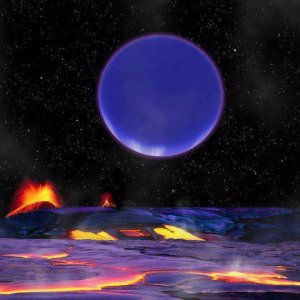
In a solar system far, far away…

Astronomers have found a planetary system that’s unlike any known system we’ve found thus far. In this system, which is approximately 1,200 light-years away from Earth, two planets orbit their parent star at an astonishingly close distance separating the two of them — a distance of a mere 1.2 million miles (1.9 million kilometers), which is about five times the distance between the Earth and the moon. In fact, they are so close to one another, if you were glancing at the night sky on Kepler-36b, Kepler-36c would look almost twice as large as the full moon does on Earth. Can you imagine the view?
The Odd Couple:
The Kepler-36 system has two known planets, Kepler-36b and Kepler-36c. Both of which, orbit a star that is very similar to our own sun, but with a little more mass and older. Moreover, as I mentioned previously, the two planets in the system are so radically different from one another, with one of them being rocky, while the other is gaseous. The two are in fact so different compared to each other, as this system is compared to the ‘norm.’
Kepler-36b is the rocky, terrestrial world that’s 1.5 times the size of the Earth, and four times as massive. Due to the gravitational forces between Kepler- 36 c (the gas-giant), Kepler-36b and the parent star (forces that constantly causes the two planets to tug at one another), Kepler-36b is likely a volatile place that experiences a large amount of volcanic eruptions and quakes. While Kepler-36c is similar in size and mass to Neptune, if Neptune had its atmosphere blown away by solar winds — lost to space permanently.

This planetary system has puzzled astronomers since its existence was discovered last year. Generally, it is unusual to find planets as different as these two are, with opposite densities and compositions, coexisting in such a small area. In fact, it kind of throws our planet formation theories off the hinges, as the most current theory suggests that rocky and gaseous planets are the result of temperature variations in the proto-planetary disk surrounding a star. Any planet with a substantial atmosphere would be a target at such a distance, leading some scientists to believe that both of the planets formed further back from the star, before migrating inward. Or perhaps they used to be more similar to one another, but they both went through some compositional changes during their trip inwards. Either way, this discovery just reaffirms the notion that we still have a lot to learn.